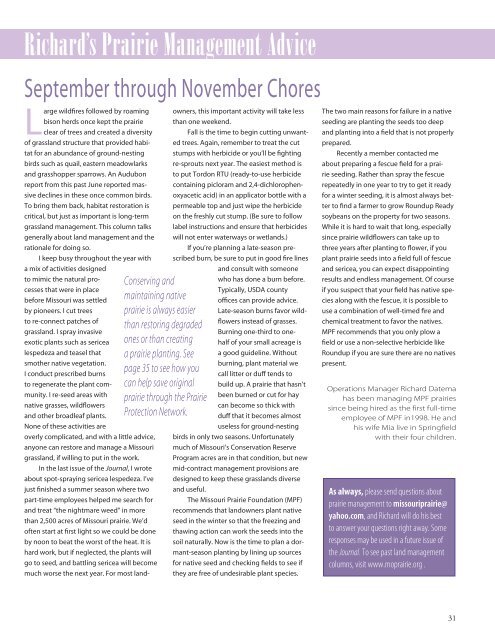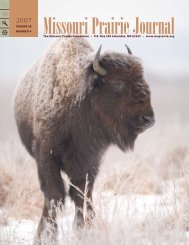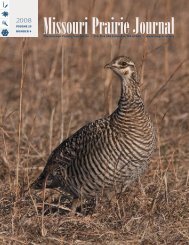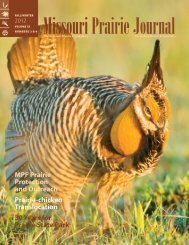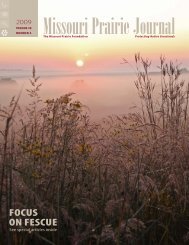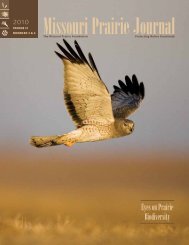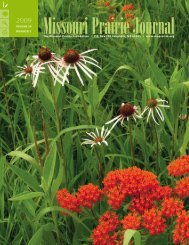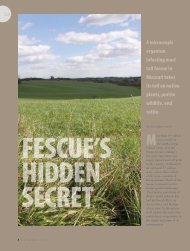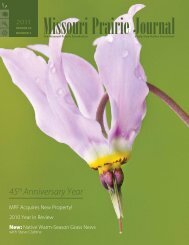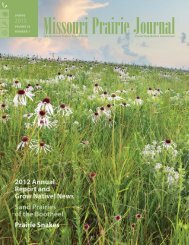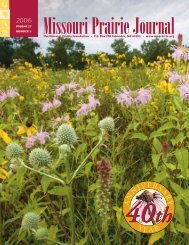Summer 2007: Volume 28, Number 3 - Missouri Prairie Foundation
Summer 2007: Volume 28, Number 3 - Missouri Prairie Foundation
Summer 2007: Volume 28, Number 3 - Missouri Prairie Foundation
- No tags were found...
Create successful ePaper yourself
Turn your PDF publications into a flip-book with our unique Google optimized e-Paper software.
Richard’s <strong>Prairie</strong> Management AdviceSeptember through November ChoresLarge wildfires followed by roamingbison herds once kept the prairieclear of trees and created a diversityof grassland structure that provided habitatfor an abundance of ground-nestingbirds such as quail, eastern meadowlarksand grasshopper sparrows. An Audubonreport from this past June reported massivedeclines in these once common birds.To bring them back, habitat restoration iscritical, but just as important is long-termgrassland management. This column talksgenerally about land management and therationale for doing so.I keep busy throughout the year witha mix of activities designedConserving andmaintaining nativeprairie is always easierthan restoring degradedones or than creatinga prairie planting. Seepage 35 to see how youcan help save originalprairie through the <strong>Prairie</strong>Protection Network.to mimic the natural processesthat were in placebefore <strong>Missouri</strong> was settledby pioneers. I cut treesto re-connect patches ofgrassland. I spray invasiveexotic plants such as sericealespedeza and teasel thatsmother native vegetation.I conduct prescribed burnsto regenerate the plant community.I re-seed areas withnative grasses, wildflowersand other broadleaf plants.None of these activities areoverly complicated, and with a little advice,anyone can restore and manage a <strong>Missouri</strong>grassland, if willing to put in the work.In the last issue of the Journal, I wroteabout spot-spraying sericea lespedeza. I’vejust finished a summer season where twopart-time employees helped me search forand treat “the nightmare weed” in morethan 2,500 acres of <strong>Missouri</strong> prairie. We’doften start at first light so we could be doneby noon to beat the worst of the heat. It ishard work, but if neglected, the plants willgo to seed, and battling sericea will becomemuch worse the next year. For most landowners,this important activity will take lessthan one weekend.Fall is the time to begin cutting unwantedtrees. Again, remember to treat the cutstumps with herbicide or you’ll be fightingre-sprouts next year. The easiest method isto put Tordon RTU (ready-to-use herbicidecontaining picloram and 2,4-dichlorophenoxyaceticacid) in an applicator bottle with apermeable top and just wipe the herbicideon the freshly cut stump. (Be sure to followlabel instructions and ensure that herbicideswill not enter waterways or wetlands.)If you’re planning a late-season prescribedburn, be sure to put in good fire linesand consult with someonewho has done a burn before.Typically, USDA countyoffices can provide advice.Late-season burns favor wildflowersinstead of grasses.Burning one-third to onehalfof your small acreage isa good guideline. Withoutburning, plant material wecall litter or duff tends tobuild up. A prairie that hasn’tbeen burned or cut for haycan become so thick withduff that it becomes almostuseless for ground-nestingbirds in only two seasons. Unfortunatelymuch of <strong>Missouri</strong>’s Conservation ReserveProgram acres are in that condition, but newmid-contract management provisions aredesigned to keep these grasslands diverseand useful.The <strong>Missouri</strong> <strong>Prairie</strong> <strong>Foundation</strong> (MPF)recommends that landowners plant nativeseed in the winter so that the freezing andthawing action can work the seeds into thesoil naturally. Now is the time to plan a dormant-seasonplanting by lining up sourcesfor native seed and checking fields to see ifthey are free of undesirable plant species.The two main reasons for failure in a nativeseeding are planting the seeds too deepand planting into a field that is not properlyprepared.Recently a member contacted meabout preparing a fescue field for a prairieseeding. Rather than spray the fescuerepeatedly in one year to try to get it readyfor a winter seeding, it is almost always betterto find a farmer to grow Roundup Readysoybeans on the property for two seasons.While it is hard to wait that long, especiallysince prairie wildflowers can take up tothree years after planting to flower, if youplant prairie seeds into a field full of fescueand sericea, you can expect disappointingresults and endless management. Of courseif you suspect that your field has native speciesalong with the fescue, it is possible touse a combination of well-timed fire andchemical treatment to favor the natives.MPF recommends that you only plow afield or use a non-selective herbicide likeRoundup if you are sure there are no nativespresent.Operations Manager Richard Datemahas been managing MPF prairiessince being hired as the first full-timeemployee of MPF in1998. He andhis wife Mia live in Springfieldwith their four children.As always, please send questions aboutprairie management to missouriprairie@yahoo.com, and Richard will do his bestto answer your questions right away. Someresponses may be used in a future issue ofthe Journal. To see past land managementcolumns, visit www.moprairie.org .31


